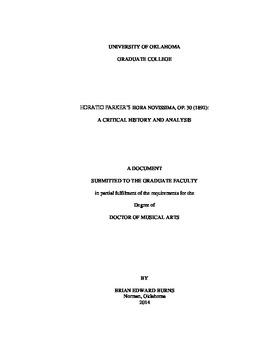| dc.description.abstract | This document is a critical history and analysis of Horatio William Parker’s 1892 cantata Hora Novissima, Op. 30, an 11-movement work for chorus, large orchestra, and four soloists. Its libretto is drawn from the 12th-century Latin poem De contemptu mundi by the otherwise largely unknown Bernard of Cluny. Parker’s setting is drawn entirely from the first of the poem’s three lengthy books, portions of the text that deal mostly with the splendors of heaven and the complete joy of the elect that will populate the celestial country. Hora Novissima was premiered in New York in 1893 and received numerous performances in the decades leading up to the First World War. While performances were less frequent in the subsequent decades, the work has never disappeared completely from the repertoire and is considered by many to be the best example of its type and an emblem of the art music of 19th-century America.
The study is divided into seven chapters, beginning with an introductory chapter that outlines the need for the study, the organization of the document, and the limitations of the study. This first chapter will also place Hora Novissima in its historical context as a representative work of the Second New England School. Chapter II is a review of the literature pertaining to the piece, its composer, and the poem De contemptu mundi followed by a brief summary. Materials surveyed are wide ranging, as literature specific to Parker and his compositions is rather limited. The third chapter is a biographical sketch of Horatio Parker, included to place the composer in his historical context and provide a more complete understanding of his compositional worldview. The poem De contemptu mundi is discussed in Chapter IV, both in terms of its history and scholarly reception and in terms of its structure. Several translations of the portions of the Latin poem set by Parker are included as a resource to those wishing to further understand the text of Hora Novissima. Both verse and prose translations are included in the hope of creating a richer tapestry of possible meanings.
The principal body of the study’s original research is found in Chapters V and VI. The former is an extended reception history of Hora Novissima, including criticism and commentary ranging from before its 1893 premiere to nearly the present day. A fairly full picture of the work’s journey is provided, with opinions of all kinds represented in an attempt to be as complete as the current record allows. The chapter is divided chronologically, which allows trends in criticism to stand out more obviously. Chapter VI follows, and is a musical analysis of the piece, arranged by movement. The seventh and final chapter is the conclusion to the document; it briefly revisits the basic ideas of the first six chapters and provides some final thoughts regarding Hora Novissima place in the repertoire.
Hora Novissima is an understudied, underperformed work. Parker was highly regarded in his own era, and many critics consider Hora Novissima to be not only his finest work, but among the finest American compositions of the 19th century. This document may be a small step in the reintroduction of both the piece and its composer to new generations of conductors and scholars. | en_US |
